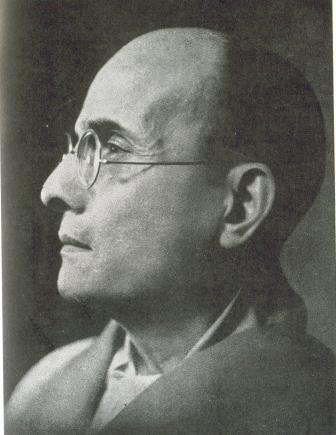Vinayak Damodar Savarkar (28 May 1883 – 26 February 1966) occupies a unique spot in India’s long and illustrious list of freedom fighters. A born leader, even as a kid he would gather a bunch of boys and be the leader of the Vanarsena. A thrill for adventure would lead this Maharashtrian to spend long hours swimming, trekking, hiking and conducting tours in and around his hometown of Nasik.
He envisioned the idea of complete freedom and liberation from the chains of British slavery. Advocating the use of arms and force to achieve the mentioned cause, he was thus known to differ with Gandhi on the policy of India’s struggle for freedom. There were many interesting tussle between the two. Unconventional in every sense of the word this poet/writer was a man of many firsts, to mention a few, such as:
- The first Indian to write a detailed account of India’s 1857 War for freedom, such was the impact of this book that it was banned by the British even before its publication
- The first political prisoner who dared to escape, unfortunately to end up being arrested on the French soil.
- The first political prisoner in the world who was sentenced to Transportation for Life twice, a feat second to none in the history of the British empire
A fierce Poet
The list goes on and on and it is impossible to rate his feats, perhaps the single most important contribution that Veer Vinayak Damodar Savarkar made for the love of motherland came in the form of a slogan that he wrote:
“One Country. One God
One Caste, One Mind
Brothers all of us
Without Difference
Without Doubt”
Needless to say that this slogan became the single great unifying call for all the Indians to come join the cause for complete Independence.
A gifted poet, he oozed out verses even during his captivity in one of the toughest prisons in the whole world. The poet in him would become relentless and when the need for pen and paper wasn’t be fulfilled by the jail authorities; he would pick up a iron nail and start scribbling on the walls of his prison cell.
He memorized tens of thousands of his lines and would later transmit them to the whole world via his fellow cell mates. He even taught them how to read and write in Marathi if needed. His impact on fellow freedom fighters can be adjudged by the fact that Shaeed-e-aazam Bhagat Singh helped bring out the third edition of his books and his works(translated in Tamil) were read out to South Indian soldiers who had decided to join the Indian National Army under the guidance of Netaji Subash Chandra Bose.
The lie and trial of Veer Savarkar
In 1909, Madanlal Dhingra, Savarkar’s follower shot Sir Wyllie. Savarkar, as expected, did not condemn the act. When the then British Collector of Nasik, A.M.T. Jackson was shot, Veer Savarkar’s name finally caught the attention of the British. He was linked to the murder citing his connections with India House which he was associated with during his London days . Vinayak Damodar Savarkar was arrested in London on March 13, 1910 and deported to India.
There is a tale here that is worth mentioning, When British police arrested Savarkar for anti-British activities at London’s Victoria railway station, as soon as his train reached there from Paris. They sent him back to India by ship in order to prosecute him. The vessel ‘Morea’ reached the French port of Marseilles on July 7, 1910. Next morning, between 6 and 7 a.m., Vinayak Damodar Savarkar escaped through a porthole and swam ashore. According to the British police, a French marine brigadier arrested the revolutionary and handed him over. Three people from the vessel helped him in the recapture.
A formal trial began which ended with Vinayak Damodar Savarkar being charged with serious offences of illegal transportation of weapons, provocative speeches of jail and deported to the Andaman cellular jail(Kalapani).
Thankfully in 1920, many prominent freedom fighters including Vithalbhai Patel, Mahatma Gandhi and Bal Gangadhar Tilak demanded the release of Vinayak Damodar Savarkar. As a consequence of this On May 2, 1921, Savarkar was moved to Ratnagiri jail, and from there to the Yeravada jail.
In Ratnagiri jail Vinayak Damodar Savarkar wrote his famous book ‘Hindutva’. On January 6, 1924 he was freed under the condition that he would not leave Ratnagiri district and refrain from political activity for the next five years.
Being a staunch supporter of the Hindu values, Vinayak Damodar Savarkar later joined Tilak’s Swaraj Party and founded the Hindu Mahasabha as a separate political party.
The Hindu Mahasabha opposed creation of Pakistan, and as expected opposed Gandhi’s continued Muslim appeasement stances. Nathuram Godse, a volunteer of the Hindu Mahasabha, assassinated Gandhi in 1948 and upheld his actions till his hanging. Vinayak Damodar Savarkar was arrested and indicted by the Government of India in the Mahatma Gandhi assassination case. But he was acquitted by the Supreme Court of India, for reasons of lack of evidence. Veer Savarkar died on February 26, 1966 at the age of 83.
Article By- Pomil Bachan Proch
